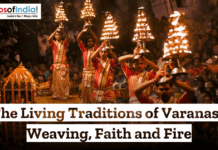In the heart of West Bengal, India, lies a confluence of spirituality, devotion, and tradition that draws millions of pilgrims and tourists annually. The Ganga Sagar Mela, held annually in January, is one of the largest spiritual gatherings in the country. This sacred event, bathed in the ethereal glow of faith, is a testament to the cultural richness and religious diversity that defines India.
Historical Roots
The Ganga Sagar Mela originates in ancient Hindu scriptures, specifically the Puranas, which mention the importance of taking a holy dip at the Ganges and Bay of Bengal confluence. The site is revered in Hinduism as one of the most sacred, and references to a pilgrimage to Sagar Island for a cleansing dip can be found in texts dating back centuries. The pilgrimage gained popularity during the medieval period when the revered sage Kapila Muni was said to have performed penance in this sacred location. Over time, the tradition evolved into a mass pilgrimage, attracting millions of people seeking spiritual cleansing and Mother Ganges’ blessings.
Geography and Significance
The Ganga Sagar Mela is held on Sagar Island, also known as Sagardwip. This mythologically significant island is located at the confluence of the Bay of Bengal and the Hooghly River. The Ganges’ purifying powers entice pilgrims from all walks of life to immerse themselves in its sacred waters.
The Mela is usually held in mid-January, during the auspicious occasion of Makar Sankranti, when the sun enters the zodiac sign of Capricorn. Pilgrims believe that bathing in the holy waters during this time cleanses them of their sins and bestows blessings for a prosperous life. Ganga Sagar Mela is an extraordinary experience due to the combination of spiritual fervor and natural beauty.
Religious Rituals and Traditions
The holy dip in the waters at the confluence is the main ritual of Ganga Sagar Mela. Pilgrims believe bathing at this auspicious time cleanses them of their sins and prepares them for salvation. The procession to the ghats is a spectacle in and of itself, with devotees chanting hymns and carrying religious banners.
The Mela is more than just a ceremonial dip; it is a vibrant gathering of various religious and cultural activities. Sadhus and saints from all over the country share their wisdom and spiritual insights. The resonance of devotional songs, prayers, and the aroma of incense fills the air, creating an atmosphere of divine transcendence.
Cultural Extravaganza
The Ganga Sagar Mela is a religious event and a cultural extravaganza that celebrates West Bengal’s rich heritage. Pilgrims and tourists are entertained by folk artists, musicians, and craftspeople. Traditional dance forms’ vibrant colors, rhythmic beats of drums, and lively performances add a cultural dimension to the spiritual ambiance.
The handicraft fair held during the Mela is a treasure trove for art lovers. Skilled artisans demonstrate their craft, offering diverse handmade products that reflect the region’s artistic diversity. The fair celebrates indigenous craftsmanship, from intricate handwoven textiles to traditional pottery.
Conclusion
In the heart of West Bengal, the Ganga Sagar Mela continues to be a beacon of spiritual enlightenment, drawing seekers from far and wide into its mystical embrace. It celebrates cultural diversity, religious harmony, and the timeless connection between humanity and the sacred waters of the Ganges.




